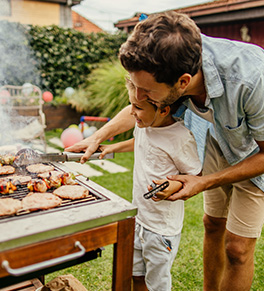Barbecue's unsung hero: Food safety

Nothing says summer like the smell of sizzling burgers on a hot grill and friends passing potato salad around a picnic table.
But there’s one guest you don’t want crashing the party — foodborne illness.
Warm weather barbecues and gatherings present opportunities for foodborne bacteria to multiply rapidly as temperatures soar.
“But keeping your picnic or backyard barbecue fun and safe is easier than you think,” says Katie E. Rankell, a registered dietitian and program director of the UCI Health Weight Management Program, part of the Susan Samueli Integrative Health Institute.
Time and temperature are the keys to safe summer grilling. Undercooking meat, poultry and fish as well as leaving food in the heat too long are are the biggest risks for foodborne illness disease, says Rankell.
When you're using the oven, you can set the cooking time and temperature, but it can be challenging to regulate the temperature on a grill. “You really need to use a meat thermometer and check for an internal temperature of 165 degrees for chicken and turkey,” Rankell says.
For whole cuts of beef, lamb, veal and pork, the U.S. Department of Agriculture recommends a minimum internal temperature of 145 degrees. But ground beef and pork should reach at least 160 degrees.
The one-hour rule
Once cooked, there is a limit to how long you can leave meat out before covering and refrigerating.
“For cooked meat, if it's left out, especially in the sun, you have two hours before it needs to be thrown away,” says Rankell. “If it's really hot outdoors, say over 90 degrees, you should only give it one hour.”
Additional foods also can be breeding grounds for salmonella, E. coli and other harmful pathogens.
“Anything with dairy or mayonnaise are especially susceptible to heat and the one-hour rule applies to them as well,” she says. Two hours is the outer limit for all other foods.
Sanitation and cross-contamination
An estimated 48 million cases of food poisoning occur each year, with 128,000 hospitalizations and 3,000 deaths, according to U.S. Centers for Disease Control. However, proper food-handling, storage and cooking procedures can help keep your family and guests safe.
“Make sure you're cleaning everything thoroughly, especially fresh produce,” advises Rankell. “And wash your hands frequently, especially in between touching raw and cooked foods.”
Use separate cutting boards, plates and utensils for raw and cooked meats, poultry and seafood.
A fresh cutting board reserved for fruits and vegetables is also recommended.
Keep marinating food refrigerated until it’s grilling time. And never reuse a marinade that has been in contact with raw meat or poultry.
When traveling to a park or picnic area, make sure meat, seafood, dairy and mayonnaise products stay well chilled in a cooler until you’re ready to cook.
Food poisoning
Rankell says the symptoms of food poisoning are pretty obvious and usually tied to spending a great deal of time in the bathroom.
It starts with stomach cramping followed by nausea and diarrhea. For some people, a fever and headache can intensify the symptoms.
If you get sick despite your best efforts, seek medical help if you've gone more than two or three days without being able to eat and the symptoms haven't lessened, says Rankell.
“If you're in one of the higher risk groups — pregnant, young children, older adults and the immunocompromised — you'll want to seek medical help a lot sooner,” she adds.
“Food safety is the unsung hero of every summer feast,” Rankell says. “But with just a few simple precautions, you can enjoy every bite without worrying!”




